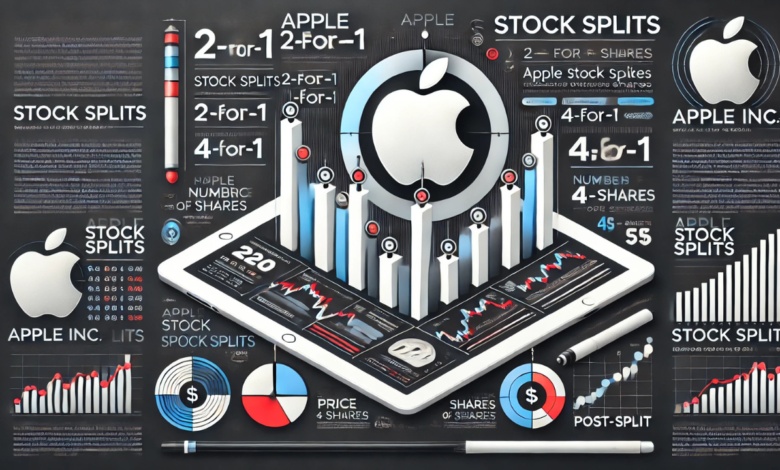Apple Stock Split: Understanding the Impact and What Investors Need to Know

Introduction
Apple Inc., one of the most iconic tech companies globally, has been a market leader for decades. Known for its innovative products and strong financial performance, apple stock split Apple’s stock has consistently garnered the attention of both retail and institutional investors. One of the key economic strategies Apple has employed over the years to maintain investor confidence and make its stock more accessible is stock splitting.
A stock split refers to a company dividing its existing shares into multiple new ones. This action doesn’t change the total value of a shareholder’s investment, as the value of each share adjusts to reflect the split. For instance, in a 2-for-1 stock split, investors receive two shares for every share they held before the split, but the price per share is halved. Despite the share price dropping, the overall value of the investment remains the same. Apple has used stock splits to keep its stock price within a desirable range, making it more appealing to a broader range of investors.
Apple’s history with stock splits is a testament to its continued growth and commitment to shareholders. This article profoundly explains how Apple’s stock splits work, why they happen, and the impact on investors.
The Process of a Stock Split
A stock split occurs when a company issues additional shares to shareholders, increasing the total number of shares outstanding while decreasing the price per share proportionally. This is typically done to make shares more affordable to a broader group of investors. When Apple announces a stock split, shareholders are notified about the ratio (e.g., 2-for-1 or 4-for-1) and the record date, determining who will receive the additional shares.
After the stock split, Apple’s stock price drops to reflect the new share structure. However, this does not change the value of a shareholder’s investment. For example, if you owned 100 shares priced at $500 each before a 4-for-1 split, after the split, you would own 400 shares priced at $125 each. The total value remains unchanged, but the stock is now more affordable to potential investors.
Understanding that a stock split doesn’t impact the company’s fundamentals or future earnings potential is essential. It’s purely a cosmetic change meant to adjust the stock price. However, it can have a psychological effect on investors. When a stock price is high, it may deter small investors from buying in. A stock split helps make the stock more accessible, potentially attracting more retail investors and driving demand.
Historical Overview of Apple’s Stock Splits
Apple’s first stock split occurred in 1987 when the company split its stock 2-for-1. The stock price at that time was relatively modest compared to today’s prices, but Apple was already positioning itself as a major player in the tech space. Over the years, Apple has executed several stock splits, each reflecting the company’s growth and increasing market value.
In 2000, Apple split its stock 2-for-1 again. At that time, the company began gaining traction with its innovative products, such as the iPod, which would soon revolutionize the music industry. The stock split helped make Apple shares more affordable, coinciding with rapid growth.
In 2014, Apple split its stock 7-for-1, a much larger split than previous ones. This split reflected the company’s remarkable growth, primarily driven by the success of the iPhone and other product lines. Apple’s stock had risen to a point where it was becoming too expensive for many individual investors to buy, so the split made the stock more accessible.
The most recent stock split occurred in 2020 when Apple split its stock 4-for-1. By this time, Apple’s market capitalization had reached incredible heights, and the stock price had surpassed $400 per share. The 4-for-1 split was intended to make the stock more affordable and appeal to a broader group of investors, particularly as Apple transitioned further into services and continued to innovate with products like the iPhone and Apple Watch.
Why Apple Does Stock Splits
There are several reasons why Apple continues to use stock splits as part of its long-term financial strategy. One of the primary reasons is to make the stock more accessible to a larger pool of investors. When a stock price becomes very high, as Apple’s did in the years leading up to each stock split, it can become cost-prohibitive for individual investors. This can limit demand and reduce the stock’s appeal to retail investors. By splitting the stock, Apple makes it easier for these investors to buy shares, increasing the overall liquidity of the stock.
Another reason for stock splits is to maintain the stock price within a more optimal trading range. While stock splits don’t change a company’s overall market capitalization, they make it more attractive to institutional investors who prefer to see stocks within a certain price range. Apple’s goal has often been to maintain a share price that allows for high trading volume without becoming too expensive for new investors.
Additionally, stock splits can signal a company’s strength and stability. When Apple announces a stock split, it reflects its confidence in its prospects and growth. Investors may view a stock split as a sign that the company is performing well and that its stock price has reached a level where it can afford to make such a move.
The Impact of Apple’s Stock Split on Investors
For investors, the impact of a stock split is typically neutral in terms of value. However, there can be psychological and financial implications. One of the immediate effects is the increase in the number of shares an investor holds. For example, if an investor owned 100 shares before a 2-for-1 split, they would now own 200. This increase in shareholding can make investors feel wealthier, even though the overall value of their holdings remains unchanged.
However, the split does not affect the company’s overall market capitalization. The stock price may temporarily dip after the split as the market adjusts to the new share structure. Still, the stock’s performance will depend on the company’s fundamentals and market conditions over the long term.
Investors should also be aware of the effect stock splits have on dividends. If Apple is paying a dividend, the payout per share will typically remain the same, but since investors now hold more shares, the total dividend payment will increase. This is a positive outcome for income-focused investors.
Lastly, some investors view stock splits as a good entry point to purchase shares in Apple. The more affordable price can attract new investors, leading to an increase in demand and, potentially, a price rise in the long term.
Future Outlook for Apple Stock Splits
It is unclear whether Apple will continue to split its stock. The company has a history of stock splits, but as its stock price has risen to astronomical levels, it may be less likely to perform splits frequently. Apple’s market capitalization is now in the trillions, and its stock price often fluctuates based on broader market conditions, so there is less need to split the stock purely to maintain a specific price range.
However, Apple’s future growth could warrant additional splits, particularly if the stock price rises significantly again. In any case, Apple will likely continue to evaluate its stock price, including investor accessibility and market demand, before deciding.
Conclusion
Apple’s stock splits are more than just financial maneuvers; they are key elements in the company’s strategy to maintain investor confidence and manage its stock price. Throughout history, Apple has used stock splits to make its shares more affordable to a broader audience, increase liquidity, and signal its financial strength. While stock splits don’t directly change the value of a shareholder’s investment, they can have a psychological impact and provide new opportunities for investors. Whether or not Apple will continue to split its stock in the future, its stock split history serves as a reminder of its impressive growth and ability to adapt to market needs.
Frequently Asked Questions (FAQs)
What is a stock split, and how does it affect my investment?
A stock split increases the number of shares you own while reducing the price per share, but the total value of your investment remains the same. For example, in a 2-for-1 split, you get two shares for every share you own, but each share is worth half as much.
Does Apple stock split every few years?
No, Apple does not split its stock regularly. It splits its stock when the share price becomes too high, making it less accessible to retail investors.
Can I lose money in a stock split?
No, the value of your total investment remains the same after a stock split, but the number of shares you own increases.
Why did Apple split its stock in 2020?
The 2020 4-for-1 stock split aimed to make Apple shares more affordable to a larger group of investors as its stock price had risen significantly, and it wanted to maintain accessibility.
How should I respond to an Apple stock split as an investor?
As an investor, you need not take any immediate action. Your holdings will automatically be adjusted, and the overall value of your investment will remain unchanged.
Does a stock split affect Apple’s market value or earnings?
A stock split doesn’t affect the company’s market value or earnings. It only changes the number of shares and their price per share. The company’s fundamentals remain the same.
You May Also Read: https://ukinfomagazine.co.uk/airsoft-fields-near-me/





